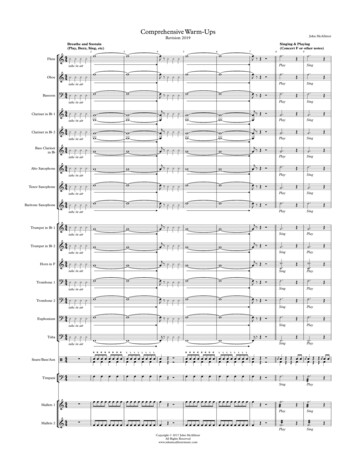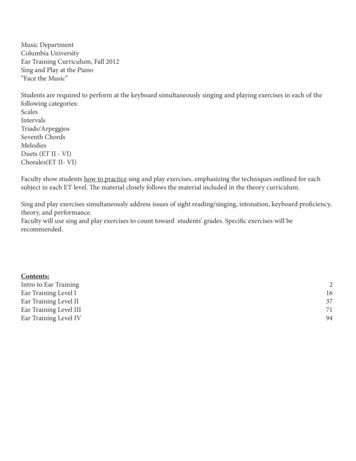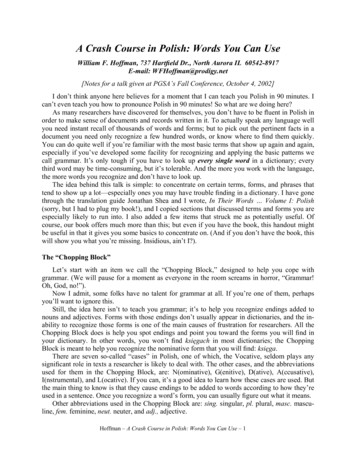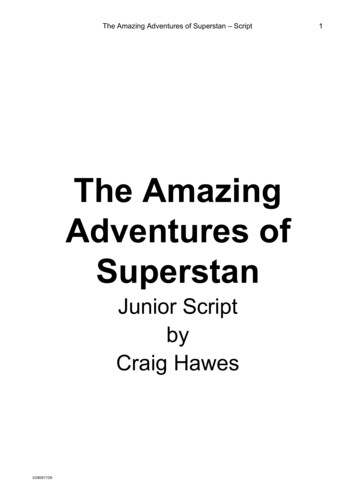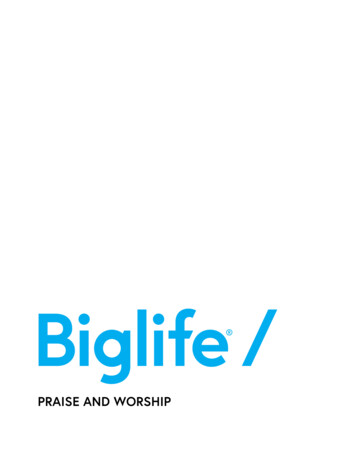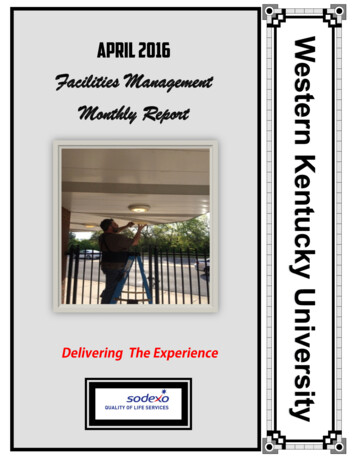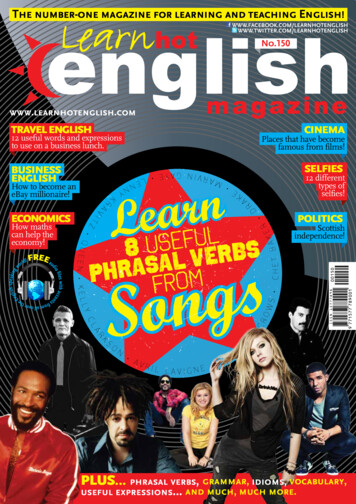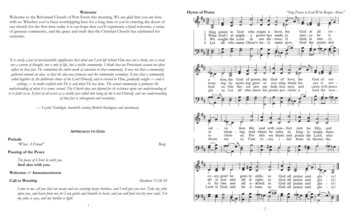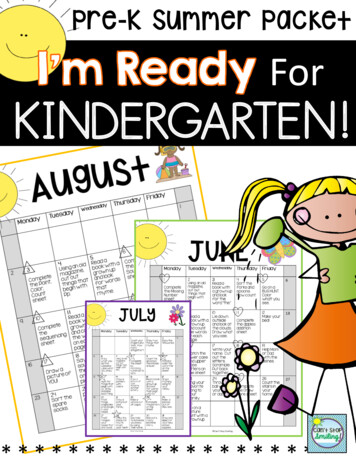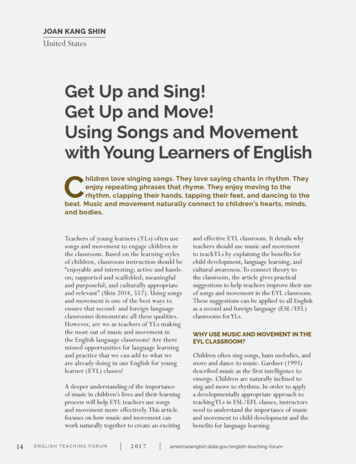
Transcription
JOAN KANG SHINUnited StatesGet Up and Sing!Get Up and Move!Using Songs and Movementwith Young Learners of EnglishChildren love singing songs. They love saying chants in rhythm. Theyenjoy repeating phrases that rhyme. They enjoy moving to therhythm, clapping their hands, tapping their feet, and dancing to thebeat. Music and movement naturally connect to children’s hearts, minds,and bodies.Teachers of young learners (YLs) often usesongs and movement to engage children inthe classroom. Based on the learning stylesof children, classroom instruction should be“enjoyable and interesting; active and handson; supported and scaffolded; meaningfuland purposeful; and culturally appropriateand relevant” (Shin 2014, 557). Using songsand movement is one of the best ways toensure that second- and foreign-languageclassrooms demonstrate all these qualities.However, are we as teachers of YLs makingthe most out of music and movement inthe English language classroom? Are theremissed opportunities for language learningand practice that we can add to what weare already doing in our English for younglearner (EYL) classes?A deeper understanding of the importanceof music in children’s lives and their learningprocess will help EYL teachers use songsand movement more effectively. This articlefocuses on how music and movement canwork naturally together to create an exciting14ENGLISH TEACHING FORUM2 01 7and effective EYL classroom. It details whyteachers should use music and movementto teach YLs by explaining the benefits forchild development, language learning, andcultural awareness. To connect theory tothe classroom, the article gives practicalsuggestions to help teachers improve their useof songs and movement in the EYL classroom.These suggestions can be applied to all Englishas a second and foreign language (ESL/EFL)classrooms for YLs.WHY USE MUSIC AND MOVEMENT IN THEEYL CLASSROOM?Children often sing songs, hum melodies, andmove and dance to music. Gardner (1993)described music as the first intelligence toemerge. Children are naturally inclined tosing and move to rhythms. In order to applya developmentally appropriate approach toteaching YLs in ESL/EFL classes, instructorsneed to understand the importance of musicand movement to child development and thebenefits for language g-forum
Music and movement are naturally connecteda positive and comfortable classroomenvironment for optimal language learning(Paquette and Rieg 2008). Singing isalso a social activity that is enjoyable andmotivating for children. Singing togetherhelps children bond and feel part of agroup.The connection between music and movementis inextricable and begins long before languagelearning begins. Starting with hearing theheartbeat in the mother’s womb, children havean innate kinesthetic sensibility to move tobeats and rhythms (Bayless and Ramsey 1991).As children grow up, developmental stagesof music and movement are interrelated. Pica Cognitive effects: Music helps develop(2013) describes how music, movement,attention span and memory (Baylessand rhythm develop together: children’sand Ramsey 1991; Pica 2013). As Hirshinteraction with music and songs progresses(2004, 101) notes, music “develops thefrom rocking or clapping along with musicmemory through melody and beat, andas babies to engaging in “active listening”through its connection to the emotions.”at about four years—singing, moving, andSongs, movement, and musical gamesdoing fingerplays. They then move on to moreare considered “brilliant neurologicaladvanced interaction, reproducing melodies,exercises” that support intellectualsynchronizing movements with rhythm, anddevelopment (Coulter 1995, 22). In fact,singing and moving with a group (Pica 2013,the combination of rhythmic movement26–27). Throughout the primary grades,with speech and song helps childrenchildren enjoy different types of music. Musicfurther cultivate their minds, includingand movement continue to be important fordevelopment of “inner speech” andtheir overall cognitive development (Copple“impulse control,” which contributeand Bredekamp 2009).to “self-management and social skills”(Coulter 1995, 22).Benefits for child development and learningAlthough many teachers know that songs arefun and can engage young English languagelearners, understanding more deeply thefollowing benefits for child developmentand learning will help them use songs moreeffectively. Psychomotor effects: Because of thepositive effects of music on brain growthand bodily systems, children should havedaily opportunities to interact with musicin the classroom (Hirsh 2004). Musicreduces stress and enhances the function ofthe immune system; it also affects the heartrate and blood pressure while improvingblood flow (Jensen 2001). Music can bemood altering. If children are overexcited,the right song can be calming and relaxing.If children have been sitting down for awhile, the right song can add energy andexcitement to the class (Pica 2013). Emotional and social effects: Music isemotional and builds children’s sensitivityfor feelings. Music and singing promoteBenefits for language learningThe use of songs in EYL classes has a numberof benefits for language learning. Music andsongs can do the following: Provide authentic, meaningful context:Using songs brings authentic language andtext types that mirror real-life listeningand speaking skills to the classroom. Songs,chants, and rap are naturally a part ofchildren’s daily lives and interests. As Shinand Crandall (2014) note, in the ESL/EFL classroom, teachers need to motivateyoung learners by providing meaningfuland purposeful activities in a context-richenvironment that helps new languagebecome more comprehensible, memorable,and useful. Introduce children to the target culture:Children’s songs are a source of rich,authentic material. Using songs with YLsis a developmentally appropriate way tointroduce children to other cultures (Hirsh2004). Pica (2013, 28–29) believes um2017ENGLISH TEACHING FORUM15
“children exposed to music have a greatermotivation to communicate with theworld, perhaps because music providestheir first exposure to the existence andrichness of their own culture, as well as theheritage and cultures of other people andregions.” Create enjoyable classroom atmosphere:Fonseca-Mora (2000, 152) points outthat “allowing students to give a choralmelodic repetition of the new language justtaught lowers their anxiety filter.” Use ofsongs creates a comfortable and enjoyableclassroom environment where childrenhave opportunities to hear the soundsof the language, build vocabulary, andimprove their listening and speaking skills. Provide opportunities to practiceoral language: Songs are effective forpracticing oral language. The melody andrhythm are useful for improving students’pronunciation and intonation of a secondor foreign language. According to Curtainand Dahlberg (2015, 370–371), songsin the target language help students“internalize the sounds, vocabulary,rhythms, and structures of the newlanguage. Students can often sing with abetter accent than they can speak with atfirst.” Aid in retention and comprehension:The rhythm and repetition in songs helplearners retain new language (Forster2006). When children sing and listento songs, they develop vocabulary andcomprehension skills (Hill-Clarke andRobinson 2004). Coyle and Gracia(2014, 282) found that young learners ofEnglish, even with limited exposure to theforeign language, could identify and retain“vocabulary contextualized in a song,”and the authors suggest “it could be thatthe combination of language, music, andactions made particular words more salientthan others.” Enhance literacy instruction: Songsare a great tool to enhance literacy16ENGLISH TEACHING FORUM2 01 7instruction (Paquette and Rieg 2008).They are effective for developing phonemicawareness, which is an understanding thatspeech is built from sounds (Yopp and Yopp2000). Some studies show that preschoolchildren who take part in programs thatintegrate music into instruction “developphonological awareness, word recognition,and invented spelling abilities moreefficiently than their classmates who donot participate in such programs” (Bolduc2008, 1). As Hill-Clarke and Robinson(2004, 95) put it, “each time childrenlearn a chant or nursery rhyme, theirreading skills grow. Each time childrenlearn a rhythmic pattern, they strengthentheir accenting and syllabication skills.Each time children learn a new song, theirmemorization and comprehension skills areenhanced.”HOW CAN WE EFFECTIVELY USEMUSIC AND MOVEMENT IN THE EYLCLASSROOM?Curtain and Dahlberg (2015, 91–92) pointout that “songs can play an important role inevery unit and every class period. They aremost effective when they are an integratedpart of the curriculum, selected for theirrelationship to all of the activities andvocabulary in a class period and not regardedas an add-on, or filler.” Songs can be a regularpart of each class in order to teach academicand social skills as well as to manage younglearners by facilitating routine activities(Cerniglia 2013; Gillespie and Glider 2010).Teachers need to know how to choose andteach a new song and integrate song activitiesthat teach new vocabulary, check listeningcomprehension, allow learners to practiceoral language, and refine pronunciation andintonation.Choosing the right songMost EYL classrooms use traditionalchildren’s songs as part of the curriculum.These authentic pieces of culture are usedto teach English-speaking children their firstlanguage and have been passed down fromgeneration to generation. The g-forum
are examples of popular children’s songs inEnglish:“B-I-N-G-O”“Head, Shoulders, Knees, and Toes”“Hokey Pokey”“If You’re Happy and You Know It”“Itsy Bitsy Spider” (or “Eensy WeensySpider”)“London Bridge is Falling Down”“Mary Had a Little Lamb”“Old MacDonald Had a Farm”“Skip to My Lou”“The Wheels on the Bus”These songs are morsels of culture used toteach children both language and contentsimultaneously. The songs embody a numberof characteristics, making them attractive tochildren and effective for teaching languageand content in a natural way. As Shin (2015a)says, “children’s songs are short and repetitivewith simple melodies and often rhyme. Theyhave a distinctive rhythm. These songs workwith children because they are catchy and easyto remember. In addition, they often havecorresponding body movements and gesturesthat help develop children’s motor skills aswell as retention.”In addition to using traditional children’ssongs in English, teachers can choose moremodern songs or even pop songs. ManyEnglish language book series incorporatenewer songs that have been created for thepurpose of teaching particular vocabulary andlanguage structures. However, teachers canuse the checklist in Figure 1 to help choose orwrite appropriate songs for a lesson.Some teachers may want to use songs andchants that come from musical approachesdesigned to teach English to YLs. Twonotable approaches are Jazz Chants and theInternational Children’s Song Approach.These approaches follow the items in theFigure 1 checklist, and the songs wereselected and/or written to be attractive inmelody and rhythm, musically simple andrepetitive, and motivating to children. Theycan be easily connected to the language leveland content of YL English language curricula.Jazz chantsJazz chants refer to songs and chants writtenby Carolyn Graham for teaching Englishas a second language. Graham’s approachuses songs, chants, and poems as exercisesfor practicing spoken American English torhythms of American jazz. According toGraham (2006), her chants reflect authenticspoken language that helps English learnerspractice the rhythm, stress, and intonationSong Selection ChecklistIs this song connected to the language and content in the lesson? compatible with learners’ level of language proficiency? attractive in melody and rhythm? musically simple (e.g., range of notes, melody, rhythm)? repetitive in text, rhythm, and melody? easily adaptable to actions and/or dramatization? motivating and interesting to children?Figure 1. Song selection g-forum2017ENGLISH TEACHING FORUM17
of natural conversation in American English.Teachers might choose jazz chants becausethey can be used with both small and largeclasses and do not necessarily require musicalability. Below is an excerpt of a jazz chantfrom Graham (1979):Where’s Jack?He’s not here.Where did he go?I don’t know.Where’s Mary?She’s not here.Where did she go?I don’t know.Most notable about Graham’s jazz chants isthat the language is like a real conversation. Infact, the language in this example could evenenhance classroom management and be usedto take attendance at the beginning of class(Forster 2006). Jazz chants were written forthe purpose of teaching English, so they arenot authentic cultural material. However, theyare a great resource for teaching AmericanEnglish in a catchy and natural way. Graham(2002) is also an excellent source for jazzchants for YLs.International Children’s Song ApproachThe International Children’s Song Approach(ICSA) by Shin (2015a) focuses on the use ofchildren’s songs from countries and culturesaround the world to teach English. ICSA isbased on the emergence of English as a globallanguage and theorizes that English does notbelong to any particular country or culture.Therefore, cultural materials used to teachEnglish—like children’s songs—should notbe limited to American, British, or any otherculture. ICSA takes popular, catchy children’ssongs from around the world and createsan English adaptation children can enjoysinging while learning language. For example,instead of learning about farm animals inEnglish by singing “Old MacDonald Had aFarm,” children can use an English versionof a song from Turkey called “Ali Baba Hasa Farm” (Shin 2015b). This approach bringsdiversity into the preprimary EYL classroom,using authentic cultural material. Songs18ENGLISH TEACHING FORUM2 01 7such as “Three Bears” from Korea and “TinyLittle Boat” from Spain can be found in Shin(2015a).Teaching a song (even for tone-deafteachers!)Some teachers love singing and have evenstudied music, so using songs to teachEnglish is also motivating to them. Someteachers do not like singing in public andmay even consider themselves to be tonedeaf. However, every teacher can learn thebasics for teaching and using songs withmovement. Now with YouTube, Vimeo, andother social-media sites, finding videos ofsongs to teach English is easy (see www.youtube.com/user/SuperSimpleSongs foran example). Moreover, English languagebook series for children usually have songswith audio and/or video resources forevery unit. Whether or not you like to singand dance, using music and movement inthe classroom to teach English can be funand effective.The first step is to be enthusiastic aboutusing songs in the classroom.You can usevideos or audio of the songs instead of yourown singing, but always do the singing andmovement along with your students.Younglearners do not care if their teacher can carrya tune, as long as they are having fun singingand moving around.Step-by-step scaffoldingIt is important for teachers to scaffoldinstruction; they need to break down tasksinto smaller, achievable steps and give studentsa model to follow. Using songs and movementis no exception. Luckily, many children’ssongs, like “Hokey Pokey” and “The Wheelson the Bus,” are short and simple and can betaught by singing the song with movementsand encouraging students to follow along.Children easily pick up the melody and startunderstanding the words by using the cuesgiven through movement and gestures. Shinand Crandall (2014) suggest steps teacherscan use after introducing children to the songsthrough video, audio, or singing themselves(see Figure m
Teaching Songs Step-by-Step Introduce the topic of the song.Review the vocabulary students already know.Pre-teach the new vocabulary.Listen to the song (with the teacher singing, or with an audio recording or video).Teach the song line by line.If there are multiple verses and a refrain, follow these steps:º Teach the refrain line by line.º Teach the tune of the verse using “la la la” instead of the lyrics (be sure to add therefrain with the lyrics at the end of the verse).º Teach the verses one by one, always singing the refrain after each one. Point out words that rhyme at the end of each line and practice repeating them whenteaching each verse.Figure 2. Steps for teaching songs to YLs (Shin and Crandall 2014)When teaching each line, teachers needto focus on the meaning of the words,making it comprehensible through visuals,realia, and gestures. During this process,teachers should check comprehensionoften, making sure students can show theyunderstand the meaning of each line.To learn to sing the song, students repeatafter the teacher line by line. The teachercan engage students in choral repetition twoways: first by speaking each line and havingstudents repeat; then by singing each line forstudents to repeat. After practicing each line,teachers and students put it all together andsing the song.singing a song about weather, teachers canask students how to gesture the words sunny,cloudy, rainy, snowy, and windy. This approachallows teachers to check comprehensionof the vocabulary and encourages studentcreativity and participation. However, it isadvisable for teachers to help students decideupon one gesture attached to the meaningof a word or phrase that everyone will usewhile singing in order to keep the movementsconsistent and avoid confusion. Then thegestures can be used in future lessons whenthe word is recycled in other contexts.Always teach gestures with songs“Listen and ” activitiesTeachers should prepare gestures for songscarefully. The use of meaningful gestureslinked with the song’s context and vocabularywill enhance language learning andengagement. Just dancing to the music canadd excitement to singing, but it can also bea missed opportunity for language learning.Adding movement and gestures to songs alsohelps students understand the meaning ofnew language and can further facilitate itsretention (Coyle and Gracia 2014). Teacherscan also invite students to suggest gestures fornewly learned vocabulary. For example, whenSong activities to engage young learnersSongs are a great way to work on buildinglistening skills. Teachers should use activitiesthat check students’ listening comprehension,especially when teaching a new song. Teacherscan check comprehension by using variousverbal and nonverbal responses. Someactivities, such as fingerplays, can be donewhile children are listening and learning tosing. Fingerplays are songs that come withhand motions or gestures that correspond tothe meaning of the words or context. Figure 3gives two examples of fingerplays withpopular American children’s orum2017ENGLISH TEACHING FORUM19
“Itsy Bitsy Spider” FingerplayThe itsy bitsy spider went up the water spout(Alternate touching the thumb of one hand to the index finger of the other)Down came the rain and(Hold both hands up and wiggle the fingers while moving hands down)washed the spider out(Move both hands out away from body)Out came the sun and dried up all the rain(Move both hands above head to make a circle)And the itsy bitsy spider went up the spout again(Alternate touching the thumb of one hand to the index finger of the other)“Thumbkin” FingerplayWhere is Thumbkin? Where is Thumbkin?(Hold hands behind back)Here I am.(Bring right hand to front of body with thumb up)Here I am.(Bring left hand to front of body with thumb up)How are you this morning?(Wiggle right thumb)Very well, I thank you.(Wiggle left thumb)Run away.(Hide right hand behind back)Run away.(Hide left hand behind back)Figure 3. Two fingerplay songsTeachers can do other activities to keepstudents engaged during songs and to checktheir comprehension. Shin and Crandall(2014) list 33 ways teachers can checkstudents’ listening comprehension. Figure 4offers a few of the “Listen and ” activitiesthat show students’ comprehension, withexamples based on some recognizablechildren’s songs.Conceptualizing activities using the “Listenand ” framework is an easy way tomake sure teachers remember to checkcomprehension. It also ensures students areactive in the listening process.20ENGLISH TEACHING FORUM2 01 7Practice and repetition activitiesYoung children learn through repetition, but therepetition should be meaningful and enjoyable.Luckily, at the younger ages, children often askto repeat songs they love. It can be fun forYLswhen the teacher plays with the different aspectsof music, such as tempo, volume, and rhythm.Altering these can also serve as languageexercises to help students improve fluency,pronunciation, intonation, and retention. Tempo: Teachers play with the tempo tomake songs more dynamic and memorable.Teachers can lead students to speed upor slow down the song in different rum
“Listen and ” Song Activities Listen and point: Students point to the correct picture or object.– Using “Head, Shoulders, Knees, and Toes,” students can point to eachcorresponding body part as they learn to sing along with the teacher. Listen and move: Students respond by moving their bodies (i.e., Total PhysicalResponse).– Using “Hokey Pokey,” students follow the directions in the song: “Put your left footin. Put your left foot out. Put your left foot in, and you shake it all about.” Listen and perform actions: Students perform or mime what they hear.– Using “Old MacDonald Had a Farm,” students sing, “On his farm he had someducks” and mime duck movement with wings and waddling. Listen and draw: Students listen to the teacher describe something and have to draw itcorrectly.– Using “Mary Had a Little Lamb,” students draw a picture that shows Mary, awhite lamb following her to school, and children laughing and playing to showcomprehension of the song. Listen and sequence pictures in the correct order: Students are given a series of pictures—large pictures on the board or a series of pictures on a handout. Students put thepictures in the correct order.– Using “Itsy Bitsy Spider,” the teacher uses the following four pictures and hasstudents sequence them: (1) the spider going up the water spout; (2) the spidergoing down the spout and rain falling; (3) the sun shining; and (4) the spider goingup the water spout.Figure 4. “Listen and ” song activities (see Shin and Crandall 2014, 135–137)Tempo GamesSpeed It Up: The teacher starts singing a song slowly, then sings it faster and faster insubsequent repetitions of the song. This is a great exercise to build fluency. For example,using “Head, Shoulders, Knees, and Toes,” students point to the body parts as they sing.The faster the song goes, the more challenging the singing and movement become.YLslove this activity, and they will also be sure to remember the word “faster” as you repeat thedirection before each repetition.Super Slow Motion: A fun tempo activity is to give instructions for students to sing a song withactions in super slow motion. Children will love slowing down the actions with their bodiesand mouths, and they can practice accurate enunciation with the exaggerated slow tempo.Figure 5. Tempo gamesStudents find the variety and change oftempo fun, and teachers can use thesetempo games to work on fluency andpronunciation. Two fun song games usingtempo are described in Figure 5. Volume: Teachers play with volume andlead students to sing songs loudly, quietly,in a whisper, or even just mouthing thewords. Using volume can add interest tothe repetition of songs, but it can also 2017ENGLISH TEACHING FORUM21
Volume GamesQuiet Down: Using “Old MacDonald Had a Farm,” the teacher starts by encouraging studentsto sing the song loudly. Students will love making the animal sounds like “quack quack” and“moo moo” loudly. Then the teacher has students sing quietly and even whisper the song,adding fun. Teachers can use this as a classroom management technique to get excitedstudents to calm down.Read My Lips: Doing the song only mouthing the words is funny but also gives the teacher achance to focus students on how they are using their mouths to formulate the words. It is afun and effective way to practice a song and work on pronunciation.Figure 6. Volume gamesa great way to focus on pronunciation.Figure 6 offers two suggestions for alteringvolume productively. Rhythm: Students can tap or shake apercussion instrument and keep the beatof the songs. Keeping the beat can helpchildren hear the rhythm of the language,help them produce stress and intonationaccurately, and improve their fluency.Using instruments to accompany songssounds great, but not all teachers haveinstruments available. Luckily, creatingpercussion instruments is easy. Almostany object can be used as a percussioninstrument when it is tapped on the flooror on a desk. Teachers may not want toencourage students to use objects such aspens, pencils, and rulers or have studentsdo rhythm games at their desks becausestudents may tap rhythms later, duringother activities. In that case, students cansit in a “rhythm circle” away from theirdesks and do rhythm activities there.Figure 7 suggests ideas for percussioninstruments that teachers can make fromrecyclable items or local materials.As students keep the beat with thesehomemade percussion instruments, theyfocus on the rhythm and stress patterns ofEnglish, which in turn can improve theirfluency, pronunciation, and intonation.Making homemade instruments is alsoa great way to teach the vocabulary ofeveryday objects and encourage thecreation of instruments through recycling.Student personalization activitiesOne way to help students develop morelanguage through the use of songs and chantsis to personalize the songs. That is, studentsEasy-to-make Percussion InstrumentsKeep the Beat Cans (or Keep the Beat Cups): Use recycled empty soda cans or plastic cups tobeat rhythms on the floor. They are light and easy to pick up, and they make a great noise.Bottle Maracas: Use a plastic water or juice bottle (or storage container) with a top thatwon’t come off easily. Fill it halfway with uncooked beans or rice and close the top tightly.Students can shake it to make a maraca sound to accompany the song. To make the “maraca”look nicer, students can cover the bottle with colored paper or decorate it with paint.Box Drums: Use recycled shoe boxes, cereal boxes, or any other cardboard box to make asimple drum. The drumstick can be an unsharpened pencil or a ruler.Figure 7. Easy-to-make percussion instruments22ENGLISH TEACHING FORUM2 01 7americanenglish.state.gov/english-teaching-forum
connect the new language and content totheir own lives. For example, here is a versefrom a song from Shin and Crandall (2015).This song, originally from Tunisia, can beintegrated into a unit about toys.I have a ball, and it’s the best!I have a ball, and it’s the best!I like my ball. It’s blue and red.I like my ball. It’s blue and red.I have a ball, and it’s the best! Yeah!I have a ball, and it’s the best! Yeah!It is fun to personalize the song by havingstudents bring in their own toys for Showand Tell and sing about them. For example, astudent who brings in a stuffed animal bear thatis brown and black can sing the verse like this:I have a bear, and it’s the best!I have a bear, and it’s the best!I like my bear. It’s brown and black.I like my bear. It’s brown and black.I have a bear, and it’s the best! Yeah!I have a bear, and it’s the best! Yeah!YLs will enjoy personalizing the song; mostimportantly, it will help them stretch their abilityto use the language in new ways and connectnew content and language to their own lives.Using songs and movement for classroommanagementSongs and chants are useful in classroommanagement. Teachers can build routinesthat help YLs know what is expected ofthem through the duration of the class. Forexample, many teachers use a greeting songat the beginning of class, a transition songbetween activities, and a farewell song at theend of class. Singing these songs can becomefun rituals for YLs that also build real languagein the classroom. Teachers have to teach thesongs at the beginning of the semester oracademic year and make an effort to keepthese routines consistent. Once YLs learn theroutines, they feel a sense of comfort andpurpose in the classroom.Figure 8 shows three routine songs teacherswill find useful with YLs. They are set tointernationally familiar tunes. These songs areshort, fun, and easy to sing, and they use reallanguage YLs can use outside the classroom.Teachers can find simple gestures for each linethat add movement to the routines. Teacherscan also create their own songs using familiarcatchy tunes like these for other routines. Someteachers like to have an attention-getter songor chant that helps manage student behavior.Others like to use a clean-up song after projectwork. It all depends on what works best foreach teacher and his or her classroom.CONCLUSIONSongs and movement are effective at makingEYL classes engaging and fun while usingan authentic form of communication thatis developmentally appropriate for YLs.YLs are still growing socially, emotionally,and cognitively, and songs and movementare important for their development inthese areas. In addition, children learning asecond or foreign language need meaningful,purposeful, and culturally relevant activitiesthat interest them and encourage them toexpress themselves in English. With practicalsuggestions in this article, teachers should beable to c
and purposeful activities in a context-rich environment that helps new language become more comprehensible, memorable, and useful. Introduce children to the target culture: Children’s songs are a source of rich, authentic material. Using songs with YLs is a developmentally appropriate
